Hardware Compatibility: Your Life Depends on It
This article is posted with permission from Occupational Health & Safety. Click here to read this article as it appeared in the April 2009 issue of Occupational Health & Safety.
By W. David Lough
Compatible connections. No, we’re not talking about dating and whether a love match will crumble or bloom. We’re concerned with fall protection equipment and the harmonious interplay of connecting hardware. Unlike finding your one true soul mate, there are multitudes of compatible configurations among fall protection components. And while lost love results in only a broken heart, hardware incompatibility is a matter of life and death.
Both lifelong users and those just introduced to fall protection equipment struggle with hardware compatibility. Unfortunately, there are cases where workers have been seriously injured or have died as a result of incompatible connections. How, in this day and age, can something as seemingly simple as a compatible connection be the direct cause of a single injury or fatality in the fall protection community? The answer is that compatible connections are not as straightforward as one might think.
WHAT IS HARDWARE COMPATIBILITY?
What exactly is a compatible connection when you are speaking in fall protection terms? First, let’s take a look at some definitions. ANSI and the American Society of Safety Engineers (ASSE) define “compatible” as it relates to fall protection as “capable of orderly, efficient integration and operation with other elements or components in a system, without the need of special modification or conversion, such that the connection will not fail when used in the manner intended.” (ANSI/ASSE Z359.0 American National Standard: Definitions and Nomenclature Used for Fall Protection and Fall Arrest) That certainly clears up any questions about what makes a compatible connection-or maybe not. After all, the definition was only for the term “compatible.”
Luckily, ANSI also provides “explanatory information” for the definition above. It reads: “Determining whether two or more pieces of equipment are compatible requires consideration of the configuration in which the resulting system or subsystem will be used. It is possible for two components to be compatible with each other when properly configured and used, but to be incompatible when configured and/or used in a different manner. For example, certain connectors may be compatible with a particular anchorage connector if the anchorage connector is located overhead, but not if the anchorage connector is located at the user’s feet.” After reading that last sentence a few times,we should surely understand what a compatible connection is-or maybe not. Perhaps this isn’t as easy as we first thought. Let’s take a look at another definition.
OSHA requires that “snap-hooks shall be sized to be compatible with the member to which they are connected so as to prevent unintentional disengagement of the snap-hook by depression of the snap-hook keeper by the connected member, or shall be a locking type snaphook designed and used to prevent disengagement of the snap-hook by the contact of the snap hook keeper by the connected member.” OSHA’s definition is useful because it may help us visualize a compatible connection and the cause of an incompatible connection. However, it does not clearly and concisely tell us what a compatible connection is and how to identify one.
To be fair, the phrase “compatible connection” is hard to define because there are multitudes of possible configurations that can be considered compatible, and for every compatible connection there is more than likely an incompatible one. Years ago, ANSI and OSHA tried to eliminate the incompatible connection by introducing auto-locking snap hooks to the fall protection world. This was a good starting point, however, there were still accidents resulting from incompatible connections.
A GIANT STEP IN THE RIGHT DIRECTION
The recently revised ANSI Z359.1-2007 standard, released in November 2007, made tremendous strides toward ensuring incompatible connections are a thing of the past. The original ANSI Z359.1-1992 standard, which had undergone only minor changes since its release in 1992, required that snap hooks and carabiners have a self-closing and self-locking gate and the ability to withstand a 5,000-pound tensile load without breaking. Many users made the assumption that the 5,000-pound load could be applied anywhere on the snap hook. This assumption is false. The 5,000-pound load may be applied only along the spine or major axis of the snap hook or carabiner. The gate of the snap hook or carabiner was required only to withstand a 220-pound load applied to the nose or front of the gate. The side of the gate was required only to withstand a 350-pound load.
There are many documented accidents that can be attributed to gate failure because of the relative ease of defeating the locking gate on the snap hook. If a worker were not educated about hardware compatibility or if he/she assumed the gate was stronger than it actually was, the possibility of failure was higher.
Fortunately, a number of additional ANSI Z359 standards, slated to be released later this year, will bring the fall protection world into the 21st Century.Among these standards, the ANSI Z359.12-200X standard (Safety Requirements for Connecting Components for Personal Fall Arrest Systems), will provide more detailed information about the design requirements for snap hooks and other connectors used for personal fall protection and fall protection systems. The ANSI Z359.1-2007 standard and the ANSI Z359.12-200X standard will require that snap hooks have a gate strength of 3,600 pounds in all directions. There is no doubt the new snap hook design will reduce the danger of an incompatible connection. However, the stronger gate does not eliminate the possibility of an incompatible connection resulting in failure of the new snap hooks. It only reduces the possibility of a catastrophic failure when an incompatible connection is made.
Images 1 & 2 below show the difference between the old 350-pound-gate snap hooks and the new 3,600-pound-gate snap hooks.
Here you can create the content that will be used within the module.
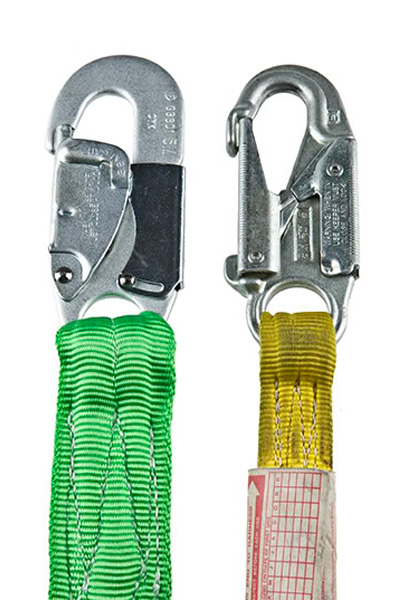
Above at Left: New 3,600-pound-gate snap hook design. Above at Right: Old 350-pound-gate snap hook design.

Above: These snap hooks are larger-sized pelican or rebar-type snap hooks. At Left: New 3,600-pound-gate snap hook design. At Right: Old 350-pound-gate snap hook design.
Those who deal with forensic analysis of fall protection accidents and provide expert opinions about why falls occur have seen a rise in the number of accidents in the past few years that are a direct result of incompatible connections. In many cases, these accidents are due in part to a snap hook that is of a size that allows the gate of the snap hook to bear on a rigid anchor. Once the worker weights the system, it was quite easy to defeat the snap hook gate even if a fall arrest load was not applied. The result in many cases was that the manufacturers of the snap hooks were accused of manufacturing a substandard product, even though the product met all the requirements of the ANSI Z359.1- 1992 standard.
This was recognized as an issue of utmost importance in the fall protection community, and reform was championed by educators, regulatory bodies,and many equipment manufacturers, even though the solution would be costly to develop. Many manufacturers had the forethought to anticipate the change in the industry requirement for stronger gates and planned to initiate design changes even before the final revisions to the ANSI Z359.1-2007 standard. Others manufacturers have resisted the change, and some consumers think that by purchasing equipment from only one manufacturer, users can ensure compatible connections. Unfortunately, this is not the case. Incompatibility of products can be found in most every fall protection equipment product line. Even so, manufacturers have always tried to promote their product lines through exclusive use of their equipment.
Since the release of the ANSI Z359.1- 2007 standard, one would anticipate that purchasing an old snap hook is a thing of the past. This is unfortunately not the case. It is still a buyer-beware market. Resistance is driven by manufacturers and consumers alike. Some consumers do not understand the change and need to be educated, and there are manufacturers that still cater to these consumers by providing them with equipment that does not meet the new ANSI Z359.1-2007 standard. Equipment that is tested or designed according to the ANSI Z359.1-1992 standard no longer meets today’s requirements. These manufacturers are testing and certifying equipment to a defunct standard, so be careful when purchasing new equipment. Don’t buy old technology. The new equipment is easy to find, yet buyers should always ask whether the equipment they are purchasing meets the new ANSI Z359.1-2007 standard.
HARDWARE TESTING REVEALS PROGRESS
Gravitec Systems, Inc., an engineering and training firm that specializes in fall protection and rescue, performed testing in 2007 to compare the function of the older snap hooks with their newer counterparts.
Images 3, 4, 5 & 6 below illustrate the position of the snap hooks in the anchor prior to a drop test which was intended to simulate an incompatible connection subjected to fall arrest forces.

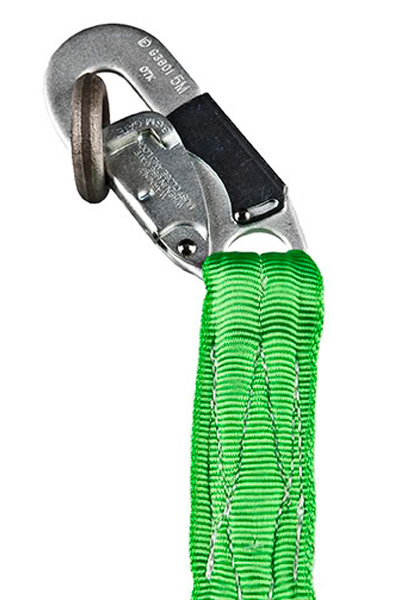
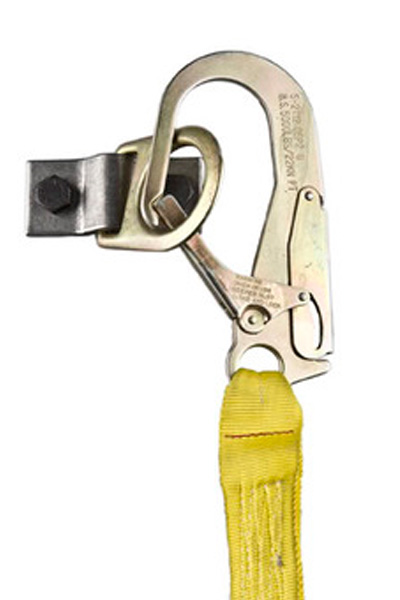
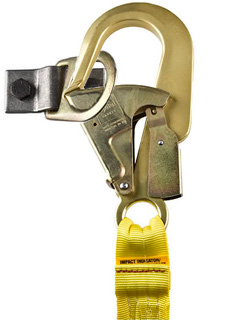
Above: An incompatible connection with an old 350-pound-gate snap hook connected to a rigid anchor. The inappropriate loading on the gate of the snap hook is apparent. This snap hook failed in a drop test in this configuration, and the test weight contacted the ground.
Above: An incompatible connection with a new 3,600-pound-gate snap hook design connected to a rigid anchor. The inappropriate loading on the gate of the snap hook is apparent. This snap hook did not fail in a drop test in this configuration. The test weight remained suspended and did not contact the ground.
Above: An incompatible connection between a pelican hook with the old 350-pound-gate design and a rigid anchor. The innapropriate loading on the gate of the snap hook is apparent. This snap hook failed in a drop test in this configuration, and the test weight contacted the ground.
Above: An incompatible connection between a new 3,600-pound-gate pelican hook and a rigid anchor. The inappropriate loading on the gate of the snap hook is apparent. This snap hook did not fail in a drop test in this configuration. The test weight remained suspended and did not contact the ground.
The intent of the drop test was to determine the extent of the problem with the old snap hooks with the 350-pound gates. It was theorized that failure was less likely to occur with the new snap hooks. Both old and new snap hooks were subjected to a maximum arrest force that modeled the impact on a fall arrest system from a personal energy absorber. In most of the tests with the old 350-poundgate snap hooks, the gates failed and the snap hook disengaged from the anchor. This was the expected result. In most of the cases, the 3,600-pound gate on the new snap hooks was not defeated. Slow-motion photography was used to document how each of the snap hooks performed. Testing was recorded at 1,000 frames per second, which allows us to see exactly how each of the snap hooks failed.(A detailed presentation on these findings was presented at the International Society of Fall Protection Symposium in Las Vegas in June 2008. For video of these tests, visit the Testing page at www.gravitec.com.)
No matter how strong we make the snap hook gate, it is possible that someone will come along with a different piece of equipment or a different way to use the existing equipment that may defeat the stronger gate and eliminate from our memory our intent to make incompatible connections a thing of the past. Of course, when that time comes, it is predictable that the manufacturers will be blamed for supplying a substandard piece of equipment.
EDUCATION KEY TO REDUCING HARDWARE FAILURE
The only way to truly eliminate the possibility of a user connecting elements of a fall protection system together that results in an incompatible connection is to ensure the geometry of the snap hook to the anchor does not allow bearing of the gate on the anchor. Because this can get complicated, there are no requirements or guidelines for this geometry. The only safeguards we have are increased gate strength and education of the people who use the equipment.
We can increase the strength of the snap hook until it can resist any foreseeable loading, however, this could make the snap hook difficult to use and carry. It can be argued that the onus is on the employer as well as the end user to understand and educate the person at risk. Knowledge is the only realistic way to attempt to eliminate the possibility of failures from incompatible connections, and although it may seem like a complex issue at first, once we sift through the definitions and become educated, we will discover it’s not that difficult to understand.
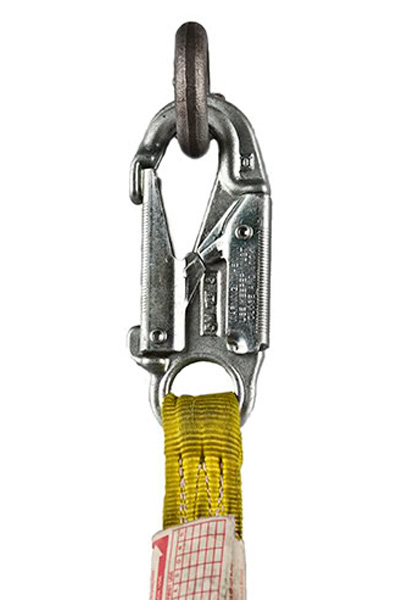
Above: A typical connection between an old 350-pound-gate snap hook and a rigid anchor. Most users would say that this connection is fine as long as the snap hook stays in this position. Unfortunately, the possibility of the locking gate of the snap hook bearing on the anchor in an incompatible connection is of concern as shown in Image 3 above.
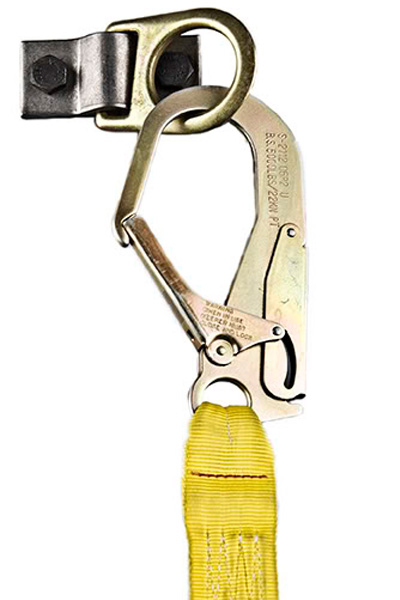
Above: A typical connection between an old 350-pound-gate pelican hook and a rigid anchor. Most users would say that this connection is fine as long as the snap hook stays in this position. Unfortunately, the possibility of the locking gate of the snap hook bearing on the anchor, resulting in an incompatible connection, is of concern as shown in Image 5 above.
ABOUT THE AUTHOR
W. David Lough is the VP of Operations for Gravitec Systems Inc., a Poulsbo, WA, consulting company that specializes in fall protection engineering, training and equipment. He has been designing, consulting and training on fall protection systems for more than 13 years and is on the ANSI Z359 Accredited Standards Committee. Lough has also aided in writing Canadian Standards Association documents and has written several articles on fall protection.

